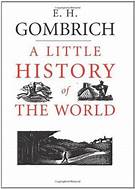
Main Characters of A Little History of the World
In “A Little History of the World,” there isn’t a central cast of characters like in a traditional novel. Instead, the book takes us on a sweeping journey through human history, from the Stone Age to the atomic bomb. The real protagonists are the events, ideas, and civilizations that shaped our world. We encounter ancient Egyptians, Mesopotamians, Jews, Phoenicians, Greeks, and more. Their motivations vary—some seek power, others knowledge, and some simply survival.
Plot of A Little History of the World
The plot unfolds across 40 concise chapters, each revealing pivotal moments in history. We witness wars, conquests, and grand works of art. The conflict lies in humanity’s struggle to progress, adapt, and survive. From the construction of the pyramids to the rise of empires, Gombrich weaves a tapestry of human achievement and folly. The resolution? Well, that’s an ongoing story—one that continues to shape our present and future.
Setting of A Little History of the World
The setting spans continents and epochs. We traverse ancient Egypt, Mesopotamia, Greece, India, and China. The Stone Age, the birth of civilization along the Nile, the golden age of Athens—all these settings influence the characters and events. The physical landscapes, cultural norms, and technological advancements shape the course of history. It’s a vivid panorama of human existence across time and space.
Themes of A Little History of the World
Gombrich explores several underlying themes:
- Curiosity and Discovery: Throughout history, humans have sought answers, explored the unknown, and pushed boundaries. Curiosity drives progress.
- Power and Ambition: From pharaohs to conquerors, the thirst for power shapes civilizations. Ambition can lead to greatness or downfall.
- Art and Creativity: Grand works of art—whether cave paintings, sculptures, or epic poems—reflect our collective imagination and cultural identity.
- Science and Limitations: Science expands our understanding, but it also has limits. We’ve harnessed fire and split atoms, yet we grapple with ethical dilemmas.
Conclusion
“A Little History of the World” invites us to marvel at our shared past. It reminds us that we’re part of an intricate tapestry—a story still unfolding. As we turn its pages, we glimpse the resilience, folly, and brilliance of humanity. So let’s continue writing our chapter, guided by the lessons of history and the promise of tomorrow.
Read more EBook summaries like…
Griffin & Sabine: An Extraordinary Correspondence by Nick Bantock.
Camera Lucida: Reflections on Photography.


